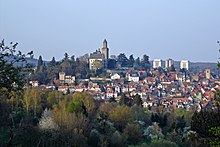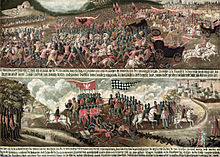Kronberg (noble family)

The Lords of Kronberg (formerly Cronberg , also Cronenberg or Cronbergk ) were a family of imperial knights who (also) lived at Kronberg Castle (built from around 1170) in the Taunus above today's town of Kronberg im Taunus since the second half of the 12th century . From 1230 at the latest until the male line died out in 1704, the castle was also the ancestral seat. Several members gained supraregional importance as German and Grand Masters of the Teutonic Order ( Walther von Cronberg ), as vehement representatives of the Lutheran faith in the Reformation period ( Hartmut XII . von Kronberg ) and as Archbishop and Elector of Mainz ( Johann Schweikhard von Kronberg )
from history
origin
Walter von Hescheburnen, mentioned in a document in 1194, is considered a progenitor . The family owned a small Motte (fortified residential tower) in Eschborn . The oldest known self-designation as that of Kronberg can be found with Otto I , who carried this family name in 1230. At that time, at the latest, the headquarters was at Kronberg Castle. The family split up several times, so that from 1252 to 1399 the three tribes crown trunk , wing trunk and ear trunk were created and they lived in their own buildings on the Kronberg castle grounds, in particular the lower castle, which was demolished in the 17th century.
Kronberg feud
On February 16, 1389, Johann, Walther and Frank von Kronberg, together with their allies, Count Ulrich V. von Hanau and other knights, declared the feud of the Free Imperial City of Frankfurt am Main . Behind the conflict were, on the one hand, disputes over supremacy in the Rhine-Main area , and on the other hand, the social shifts at the end of the Middle Ages , when knights and lower nobility threatened to decline compared to the emerging bourgeoisie and the high nobility, which gained power with the territorialization process . One symptom of these disputes was the robber baronism that ambushed convoys of city merchants. On May 14, the allied nobles defeated the Frankfurt armed forces in the battle of Eschborn and captured over 620 Frankfurt citizens, including all bakers and one of the two mayors. They released the prisoners for a ransom of 73,000 guilders . The city then formed an alliance with the Kronbergers and incorporated them into its politics: in 1394, Hartmut von Kronberg signed them as bailiff for the Frankfurt villages based in Bonames , and in 1395 they also allied themselves with Johann von Kronberg.
Early modern age
Hartmut XII. von Cronberg , a cousin of Franz von Sickingen , had assisted him in his attack on Trier and Worms . In 1522 a coalition of Archbishop Richard von Greiffenklau zu Vollrads of Trier , Ludwig von der Pfalz and Landgrave Philipp the Magnanimous besieged the city and Kronberg Castle and forced their unconditional surrender. Hartmut XII. escaped. Landgrave Philipp occupied Kronberg in the following years and in 1526 it became Lutheran under him . In 1540 Philipp entered into a second morganatic marriage with the Saxon court maid Margarethe von der Saale , while his wife was still alive. With this bigamy , Philip encountered far-reaching political difficulties. Therefore he had to give the castle and town of Kronberg to Hartmut XII in 1541. hand back. But this happened on condition that the Lutheran Reformation be preserved.
meaning
The family belonged to the Rheinischer Ritterkreis . In 1617, with the death of Johann Eberhard von Kronberg , Vicedominus of the Rheingau and Mainz hereditary tribe, the wing tribe of the von Kronberg family died out. In 1618 the Kronbergers, of which only the Kronen tribe still existed, were raised to the rank of baron , and in 1630 to counts . In 1632, the Kronberger Amt received Rothenberg in the Odenwald as a fief.
The last family members no longer lived at Kronberg Castle. In 1704 the family died with the death of Johann Nicolaus von Cronberg, who lived at Hohlenfels Castle in the Hintertaunus . The Rothenberg rule fell to that of Degenfeld , the Kronberg rule to Kurmainz .
coat of arms
Blazon : square; Field 1: in red a golden crown, fields 2 and 3: in silver four (2: 2) blue iron hats, field 4: red. On the helmet with red and silver covers a black thistle umbel. In Scheibler's book of arms, the fields are reversed, so the arms are shown reversed; Furthermore, the helmet covers at Scheibler are black and silver. The Kronberg coat of arms was adopted by Wörth am Main as the city coat of arms.
Significant family members

See also the list of the Kronberg family
- Hartmut IV. Knight of Kronberg received city rights for the castle settlement from Emperor Ludwig the Bavarian in 1330
- Eberwin I. von Kronberg († 1303); from 1299 to 1303 Bishop of Worms
- Walther von Cronberg (1477–1543), German master from 1526 and from 1527 to 1543 also Grand Master of the Teutonic Order .
- Hartmuth XII. von Cronberg (1488–1549) was one of the first followers of Martin Luther , pioneer of the Reformation in southern Germany and supported Franz von Sickingen
- Johann Eberhard von Kronberg (1547–1617) was bailiff of Alzenau and later burgrave of Friedberg
- Johann Schweikhard von Kronberg (1553–1626), grandson of Hartmuth. XII., Was elector and archbishop of Mainz from 1604
- Wilhelm von Cronberg , Grand Bailli of the Order of St. John, was also the commander of several people coming to St. John.
- The brothers Hartmut von Cronberg (around 1615–1685) and Johann Daniel von Cronberg (around 1616 – after 1668) were court officials of the Electorate of the Palatinate and members of the Fruit Bringing Society
- Her cousin Johann Nicolaus von Cronberg (n. 1633–1704) died without children and without children as the last male member of the family
literature
- Julius Kindler von Knobloch : Upper Baden gender book. Three volumes. Carl Winter's University Bookstore, Heidelberg 1898–1919. Volume 2 here, pp. 384–386 online
- Sabine Arend: Catholic gentlemen - Protestant subjects. The Kronberg church order of 1585. In: Nassauische Annalen , Vol. 125 (2014), pp. 67-106.
- Helmut Bode: Hartmut XII. von Cronberg, Imperial Knight of the Reformation , Verlag Waldemar Kramer, Frankfurt am Main 1987, ISBN 3-7829-0356-0 .
- Hellmuth Gensicke : Kronberg's . In: Nassauische Annalen, Vol. 98 (1987).
- Angela Metzner: Reichslandpolitik, aristocracy and castles - studies on the Wetterau in the Staufer period. Büdingen 2008/2009, ISBN 978-3-00-026770-3 , pp. 162-165 ( Büdinger Geschichtsblätter 21 ).
- Walther Möller: To the genealogy of the von Cronberg. In: Nassauische Annalen, Vol. 45 (1916/1917), pp. 223-229.
- Markwart Mueller-Hillebrand: Cronberg: History of a knight family. , Waldemar Kramer publishing house, Frankfurt am Main 1950.
- Wolfgang Ronner : The von Kronberg and their women: Encounters with a knight family , ISBN 3-7686-6035-4 .
- Wolfgang Ronner: Family table of the knights, lords and counts of Kronberg . Kronberg 1981, ISBN 3-9800322-1-3 .
- Wolfgang Ronner: The Lords of Kronberg and their Imperial Fief 1189–1704. Regesten and additional texts. Waldemar Kramer Verlag, Frankfurt am Main 1999, ISBN 3-7829-0507-5 .
- C. Frh. Roth von Schreckenstein: History of the formerly free imperial knighthood in Swabia, Franconia and on the Rhine . Vol. 2, 1859ff, p. 594.
Individual evidence
- ^ Gerhard Köbler : Historical Lexicon of the German Lands. The German territories from the Middle Ages to the present. 4th, completely revised edition. CH Beck, Munich 1992, ISBN 3-406-35865-9 , p. 319.
- ↑ According to Siebmacher's book of arms, panel 124.


